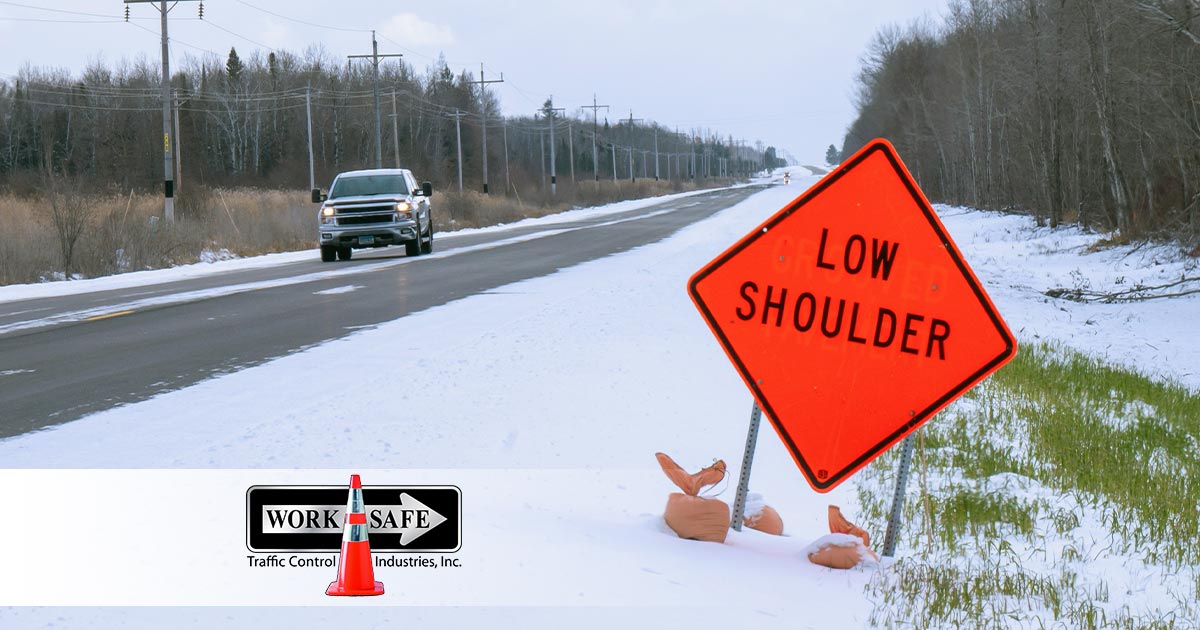
The low shoulder sign is a road condition symbol that is most often seen where the road is crowned, has a soft bedding material right at the edge of the asphalt, or where it drops off suddenly from a level flat surface to a slope. All these conditions essentially can mean a high-risk situation for the weight of a car veering to the side and expecting stability, when, in fact, it could cause a roll-off and an accident.
The warning sign then is a critical notice for the driver to be aware of the potential problem ahead of time. However, the sign is very similar to a few others, which can make things a bit confusing. The key thing to remember is that the low shoulder sign is always spelled out with words, not symbols. The following will explain this nuance bit more.
A Common Trick Question
Many states use the low shoulder sign as a trick question on their driver’s license test in the written portion of the exam. The nuance is compared to a shoulder drop-off sign. The difference is that the drop-off sign literally means a sharp edge and lower level, while the soft shoulder sign is a gradual slope versus the flat road.
The drop-off edge is also a very visual sign. It literally shows a car dropping off the sharp edge of the road with no transition down. The low shoulder sign has no symbology; it consists of just words that spell out a version of “Caution, Low Shoulder Ahead.”
While one would think that this difference can be obvious, believe it or not, as many as two-thirds of test-takers in multiples states miss this trick question. No surprise that it is one of the favorites to check if applicants are indeed studying and making sure they understand the rules of the road versus just knowing how to drive a car physically.
Other signs can be confusing as well. The sharp turn sign can also be mixed up visually at a distance, both in words and color. The Low Shoulder sign is yellow, black print for the words, and diamond shaped. It is easy to mix up when driving at night with an entrance sign, as well as about 16 other signs, including speedbumps, dips, a “be prepared to stop” sign, loose gravel, and lot more. It is no surprise that people miss the symbology often because words can be easy to confuse, especially when the driver does not have 20/20 eyesight or is tired.

The Meaning of the Low Shoulder Sign
A low shoulder situation does not include the sharp angle of a sudden drop-off, as mentioned earlier. However, it cannot be relied on for safe driving either. Many lower shoulders are associated with hills and edges that drop off dramatically, so even the least amount of driving on them can be risky and pull the driver off the road with gravity.
Unlike sharp edges, which offer no ability to return at speed, the low shoulder can be recovered from if one is expecting it. However, if a driver is caught by surprise, a serious accident is likely to happen. There is also no level of adjustment for a Low Shoulder sign. It simply appears as a warning, and that is it. So, anyone trying to judge the level of fall-off is making an unnecessary mistake and risking trying to outthink the warning. It is better to just avoid the road’s edge altogether.
How to Recover if You Find Yourself on a Soft Shoulder
The normal reaction to losing control is to hit the brakes. The assumption is that by slowing down one will automatically gain control of the car. However, this is oftentimes not the case. For example, slamming on the brakes on a wet road could make the car end up in an uncontrolled skid. The same could happen when applied on non-solid ground such as soil and gravel.
In fact, the better approach at first is to keep the vehicle moving in a safe direction versus losing control of it altogether. The friction of the tires with loose soil will slow on the natural terrain. This is one of the reasons why runaway semi-truck paths are filled with soft gravel and soil. As the vehicle slows in a straight direction, then the driver can apply the brakes and come to an eventual stop.
But how many folks remember to go through this reaction process when it surprises them? Not many; it takes a lot of driving experience and strength of mind to know what to do under pressure.
Obtaining Quality Low Shoulder Signs
If your jurisdiction needs replacement signs or new signs for areas of road that have always been risky or newly affected by weather, then Worksafe Traffic Control Industries can help. We produce all types of traffic signs for all types of road conditions. Our products are durable, high-quality, corrosion-resistant, and long-lasting. The results are safety on your roads, your jurisdiction, and an efficient use of your funds for road signage and similar. Give us a call or email to find out more.
We can show our product and production line as well as scope out what will be the most feasible run for your needs and expectations. Safe roads take people to make them safe with planning, good product allocation, and anticipation of where drivers and traffic can get in trouble. Prevention is a lot cheaper than damage cleanup. And it saves lives, which is the most important thing of all, on the road or off.

